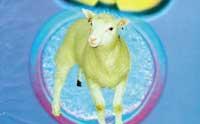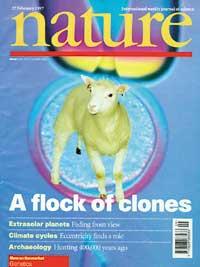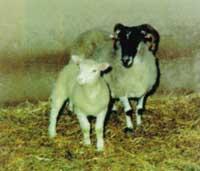The question of cloning from a biological point of view
Born “Dolly”
These experiments are scientifically very significant and are recognized by experts in genetics and developmental biology. However, the hustle and bustle we referred to is not the academic-scientific emotion of a few, but the surprise, dream, or fear that has occurred in ordinary people, in anyone who does not dress up in these subjects. And not for manipulations with plants and animals in the field of biotechnology. Responsibility is due to its direct effect on the human being. If this has been achieved with sheep, the cloning of the human being (at least technically and even if not short-term) would be available.
The subject of cloning, therefore, has become a public problem that must be made available to other experts. Two types of questions are mainly posed:
- Is it ethical to try to clone human beings?
- Should it be legal from now on?
In short, it seems that we are facing a question that is posed to all:
- Is it just to cry out to man? (Or clone living beings in general?)
It seems, however, that, in view of the answers given to this question, another basic question that does not interest anyone has not been successfully overcome:
- Is it feasible to clone to man?
That is, what kind of cloning do we talk about? Is the cloning being discussed like the technique used to “create” Dolly? Are the clones we repeat similar to Dolly and his companions? And if so, does this concept have to be seen with the mythical cloning that has arisen in people? Does it really mean that identical copies of people have begun to be made?
Should we not make sure that we have defined what we are talking about well before entering into fundamental debates? It is possible that many other techniques and practices of genetic engineering less spectacular, since they are basically used and are already much more worrying and should be discussed socially. It would be regrettable, therefore, that this second would be covered (or mixed class) intentionally or unintentionally with the first.
Background of the topic
Currently, one of the most important research fields for all biology is development. Above all, analyze the details of the relationship between the genetic supply and all other cell equipment. What to say in the field of biotechnology! The total success of many genetic manipulations of different types is hindered by ignorance about the processes of development. However, in most cases, when we talk about cloning in the media, we do not talk about the problem of multicellular development. In fact, cloning becomes an almost magical instrument that we could have to avoid the problems of development, that is, the way to make the same copy of an organism. Of course, direct route. And there is the lame.
Clones, cloned
“Clone.- (N. biol) Set of descendants formed by asexual reproduction of a single individual or cell. Genetically they are identitarian by the type of reproduction” (E.O.E. ).
Although it seems surprising, in biology most of the uses of the word klon and concept are quite normal or unpublished. It is something that happens naturally in unicellular organisms and other microorganisms. You can also call clone to the cellular subset that comes from a single cell in the pluricellular organism.
In the plant kingdom it does not usually occur spontaneously, but it has almost always been possible to do it by artificial manipulation, using buds or strawberries. Varieties created for crops such as industrial, such as corn, can also be clonic (when they reproduce completely homozygous lines between themselves).
In general, most of the cell cultures that are carried out in the laboratories have suffered a certain cloning for a long time. However, other techniques invented in the field of biotechnology are recent. For example, it is said to clone the parts or sequences of nucleic acid (DNA) when they are introduced into vectors (plasmid) and copied with the receiving cell. Although this technique is very important in genetic engineering, it has not been the one that has attracted the most public opinion.

This privilege has been a new use, cloning by transfer of cores. These experiments are also not of this morning, since they began in the 60s. The English embryologist John Gurdon then carried out a series of experiments with apoos. The eggs were removed from the nucleus and placed the nuclei of other cells. In its beginnings, it worked for the nuclei of some cells of the new sapo embryos and, in most cases, it achieved the development of normal mature foams and toads. He also used abdominal cells and adult skin cells. It had several successful results (Figure 1) but in many fewer cases.
However, sterile toads developed from mature cells. It's still not entirely clear why, but experts believe it should be due to a change in the core genetic information. Moreover, these results obtained with amphibians could not be repeated in mammal animals, as evidenced by the failure of the rats studied in depth. Also in this case, according to most, the cause lies in those supposed genetic variations, which can be irreversible because they are given rapidly in the embryo of mammals (Wolpert, 1991).
In fact, Edinburgh groups conducted their research on the problem of irreversibility and the nature of changes in genetic information during development. And in the context of this problem, we must understand, therefore, the importance of its success. In addition, a few years ago it was thought that it was not yet possible to obtain these results.
Results published in the journal “Nature”
The team of the Roslin Institute had already carried out experiments for the cloning of mammals (Campbell et al., 1996). These are experiments to obtain viable clonic organisms, sheep, by transferring the cores. For this purpose, cells belonging to a cell line derived from an embryonic cell (up to all parts) were used. By fusing these cells with nuclear-free eggs, they formed embryos and applied them to the sheep to develop until the end (Figure 2). Thus they managed to give birth to five living lambs.
The next step seemed logical in this line of research. Use of more developed cells (that is, more separated and therefore not all). To do this, cells were first removed from different tissues of sheep. In fact, the origin of these cells was triple: From a 9-day embryo in a sheep of the Poll-Dorset, a 26-day fetus in a sheep of the Black Welsh and the mammary gland of a 6-year-old sheep in the Finn Dorset. Using a technique developed for the first experiments (figure 3), the culture of stopped cells was prepared in a specific situation of the cell growth cycle.
Subsequently, the eggs of other sheep of the Scottish Blackface were nucleated. They then merged and activated donor cells and nuclear-free eggs using electrical pulses. Finally, the embryos were transferred to other receiving sheep, also from the Scottish Blackface, which allowed them to develop until the end. Thus were born eight living lambs (one of them died immediately).
Above all the lamb number 6LL3 became the head of those experiments, since it was the one developed from a 6 year old breast cell. It was the first mammal to develop from the cell from an adult tissue. That is what they baptized as “Dolly” and the lamb we could see in all newspapers and television stations.
This complex cellular dance between different groups of sheep resulted, at least in most of the media, that the lambs born were copies of the donor cell (and not of the mother sheep that gave them or of the madrastras that offered eggs). The first thing to say about this is that when saying a copy, it was rarely added the essential adjective: the genetic.
For scientists, however, it can be said that the exact result of great importance is another, and that is the second nuance worth mentioning. As explained, the goal for scientists (at least the first) was to investigate what happens with genetic information throughout development as a result of cell separation. The protagonists said:
“The transfer to the unfertilized egg of the nucleus without nucleus in a certain development phase allows to investigate whether or not cell separation has irreversible genetic alterations. (...) The fact that the lamb is a consequence of an adult cell ensures that the separation of this cell does not imply an irreversible alteration of the genetic material necessary for integral development.” (Wilmut et al., 1997, 810 h).
According to this result, all genetic information is always present, but if the nucleus and cytoplasm are prepared in appropriate conditions, the whole organism can be generated from the beginning. It demonstrates the capacity of cytoplasm to reprogram the expression of the core genes, returning the nucleus to the state of fullness.
Development and genetics
As is often said, one of the great miracles of life is multicellular development, that is, how from a single cell, division and separation, can a complex organism be formed? That is, these few initial cells are not only divided, but differ according to the different biological functions.

Despite all these processes of cell division and separation, all cells of an organism contain practically the same and complete genetic information in their nuclei. That is to say, in the nucleus they have throughout their life twice as many chromosomes that carry the genes. On the other hand, the development process is somehow governed by genes, but not by themselves. Most of the genetic information is found in the cell nucleus and is expressed with the help of the cell cytoplasm. In cytoplasm there is also genetic material and an effect called maternal inheritance occurs, very important at the beginning of development. In general, the genes are there, but they do not do much if they are activated and therefore are not expressed. And this activation process is the result of a complex network in which other genes, cytoplasm and cells of the environment are involved. The interaction between the nucleus and cytoplasm is absolutely necessary.
However, according to what we know about development, the genetic information that cells carry as they separate them seems to suffer some change, since it is no longer capable of performing any type of cell. In the early phases of the embryo (morula, blástula) it is said that the cells that are formed by division are all. Omnipotence is the ability to provide the genetic program necessary to govern the development of the entire individual inherent in a single cell. This is the capacity that is lost and not the genes. That is, little by little each cell is still able to express only a few genes (and not others). In this sense, normally, from an adult cell the whole organism cannot be developed, except of course the germinal cell involved in reproduction.
Within all this diversity, a double classification has priority: the germinal cell and the somatic cell. Somatic cells are those that constitute any organ, bone, or tissue of the organism. Germ cells are sex cells, gametes (eggs and sperm, for example), the only ones involved in reproduction when the organism reaches maturity. That is why they supply their genetic supply to the posterior organism.
While all other cells in the body have a double group of chromosomes (diploids), gametes participating in reproduction have a single group of chromosomes (haploids). Thus, the embryo resulting from the bonding of the egg and sperm after fertilization has a double group of chromosomes (and not a quadruple). The direct consequence of this is that in organisms that reproduce by sexual reproduction, children and their parents are genetically different. Each child receives half of the genetic endowment of each parent, but never half.
Likeness of Likeness
Apart from technical details and problems, what changes with cloning (especially with the transfer of the nucleus) is that the organism that normally occurs by sexual reproduction occurs from a single diploid cell. This makes all the cells of the new organism have the same genetic material as the donor nucleus cell, that is, they are genetically identical. It's time to wonder what it means to be genetically equal or have a genetic copy. We must be aware that, as explained above, this genetic information must be represented and that in this process other participants in the environment should be taken into account.
In biology, two types of descriptions of any organism are distinguished: genotype and phenotype. Genotype is the genetic or hereditary formation of an organism. The phenotype is the set of characteristics present in an organism, conditioned by its genotype and its medium. The phenotype is formed by both morphological and behavioral characteristics. According to what we know today, this relationship between genotype and phenotype is from a lot to a lot, that is, with the same genotype there are different phenotypes and the same phenotype is also with different genotypes. Always depending on the environment.
Development is a complex process in which multiple factors intervene at different levels. The core genomes are only one of those factors, very important and perhaps more fundamental than others, of course, but in no case the only or the almighty. In the case of a person, in addition to the genome, other factors to consider form a small list. First within the genome we have the same dynamics between genes, including errors and repairs that will not always be the same. Then there is a maternal, cytoplasmic heritage, which can be different in each ovum. Then, the environment of the maternal womb, totally changing. Finally, the family, social and cultural environment at birth, which can be much more different.
Although the genotype of the organism is the same, any factor of this type can be different. That difference will be small or large, in appearance or in behavior, ability or speed, but for anyone who wants to make a copy of a person is too doubtful. And for him, the characteristic that can be more important in the model is under the control of who knows or which group of factors.
The intelligence of a person, honesty, compassion, fraternity, ... and many other cognitive-emotional or socio-cultural characteristics of this type, who can think that with the simple copy of the genes they will be reconstructed in the same way in any other person? And if you can't just copy genes, who should guess the magic technique to copy all the factors we don't know or can't control?
As a conclusion, as a conclusionMany are going to say that even if human cloning is not possible, in case you can't ignore the debate about cloning and you have to face it today. But if we do not know exactly what we are talking about, we can hardly avoid the risks that all this can generate. In addition, this impossible cloning, isn't it going to hide other problems or threats that biotechnology itself brings us? In other words, perhaps the prohibition of phantasmagoric cloning to the present society is offered in exchange for accepting other more partial genetic manipulations.
So, to conclude, if we deal with genetic clones, should we not worry so much about this “clonic” cultural environment that we are doing?
Buletina
Bidali zure helbide elektronikoa eta jaso asteroko buletina zure sarrera-ontzian










